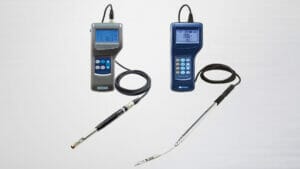Duct Traverse with Kanomax Anemometers
Continuing along the theme of our last post, achieving and maintaining optimal HVACR system performance can be extremely beneficial and, often, even essential. As we mentioned in the duct leakage post last week, when air does not move through the duct system as intended due to some failure or imperfection, the results can be significantly adverse. This week, our focus is on duct traverse using anemometers. The instruments are designed to measure air velocity, which is especially important for duct systems because incorrect air velocity can cause several negative effects, including: poor conditioning of the air, increased operating costs, shortened equipment lifespans, wasted energy, etc.

The most accurate way to determine optimal performance within a duct system is to traverse the duct in question. ‘Traversing’ is collecting a series of air velocity and pressure measurements from regularly spaced points throughout a predetermined cross-section of the duct. To summarize the process of traversing a duct, obtain several measurements from the selected portion of a straight duct, and average the velocity readings from each of the measuring points. The reason this method is the most accurate, is because air flows at different speeds and with distinct levels of pressure in varying parts of the duct, i.e., the air moves more quickly at the center of the duct, while pressure can be higher at certain gathering points along the duct walls, etc., therefore, by taking multiple spaced measurements in a section, the outlying/misrepresentative data can be muffled and a clear trend can be identified. There are certain recommendations for minimum measurement quantities based on duct characteristics:
- If duct side is less than 30”, use 5 measuring points
- If duct side is between 30” and 36”, use 6 measuring points
- If duct side is 36” or more, use at least 7 measuring points
- If duct side is less than 18”, take readings from center of equal areas set them 6” or less from each other – take a minimum of 2 readings on each side of duct
- In supply duct, the ideal location of the traverse in a straight duct will have 10 duct diameters upstream and 3 duct diameters downstream
- To determine equivalent duct diameter:
- Equivalent duct diameter = √ (4HV/π)
H = horizontal duct dimension
V = vertical duct dimension
π = 3.14
- Equivalent duct diameter = √ (4HV/π)
- To determine the depth at which the anemometer probe should be inserted into the duct, use the appropriate multipliers in the table below:
- To determine equivalent duct diameter:
| Multipliers to Determine Depth of Measuring Device | |
|
Number of Points or Traverse Lines |
Position Relative to Inner Wall |
|
5 |
0.074, 0.288, 0.500, 0.712, 0.926 |
|
6 |
0.061, 0.235, 0.437, 0.563, 0.765, 0.939 |
|
7 |
0.053, 0.0203, 0.366, 0.500, 0.634, 0.797, 0.947 |
Once both the importance and process of duct traversing are understood, the correct instrument is essential for maximum measurement accuracy and efficiency of use. Kanomax handheld anemometers are carefully designed to remain comfortable when held for extended periods of time, although their user-friendliness and intuitive interfaces ensure the speedy completion of numerous measurements. The Climomaster™ Model 6501 is the most accurate hotwire anemometer of its kind, with a variation of just 2% of reading. It’s also among the most versatile anemometers available, as there are eight available probe options, made up of four different types, including: rod, needle, spherical and miniature. The Climomaster™ is capable of measuring air velocity, temperature and relative humidity simultaneously, depending on the choice of probe. It has a datalogging capacity of 20,000 records, which can be transferred quickly and easily to a PC for analysis. With its many available options of accessories, using this anemometer can become nearly effortless due to the hands-free carrying case, assorted styles of extension rods and plenty of varying cable lengths. Although the Climomaster™ is a surprisingly affordable research-grade instrument, we offer an even more economical option in the form of the Anemomaster™ Model 6036, which boasts many of the same features.

In sum, accurate measurements and analysis of air flow are essential in determining the overall performance of HVACR systems and employing the right equipment, like Kanomax® anemometers, will result in the peace of mind that comes with a job done right.

